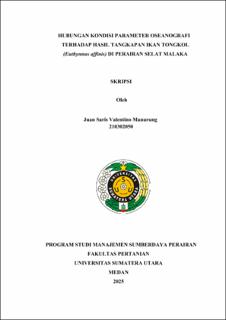Hubungan Kondisi Parameter Oseanografi Terhadap Hasil Tangkapan Ikan Tongkol (Euthynnus Affinis) Di Perairan Selat Malaka
The Relationship Of Oceanographic Parameter Conditions To The Catch Of Skipjack Tuna (Euthynnus affinis) In The Strait Of Malacca

Date
2025Author
Manurung, Juan Saris Valentino
Advisor(s)
Fadhilah, Amanatul
Metadata
Show full item recordAbstract
This study aims to analyze the relationship between oceanographic parameters and skipjack tuna (Euthynnus affinis) catches in the Strait of Malacca. Specifically, it seeks to characterize oceanographic conditions (sea surface temperature, currents, salinity, and nutrients) in the Strait of Malacca and to determine their influence on skipjack tuna catches. This study also aims to provide recommendations for sustainable fisheries management based on these findings. Using a quantitative approach, sea surface temperature (SST), chlorophyll-a, surface currents, salinity, and nutrients data were obtained from satellite imagery (Aqua MODIS level-3 for SST and chlorophyll-a, Marine Copernicus for currents and salinity) for the period 2020-2023. Monthly tuna catch data were collected from the seine fleet landing at the Belawan Sea Fisheries Port for the same period. The research methodology included software such as SeaDAS 9.1.0 and ODV used for data extraction and mapping. Salinity data was processed using Microsoft Excel. This study used Catch per Unit Effort (CPUE) analysis to evaluate fishing effectiveness and Pearson correlation analysis to assess the relationship between oceanographic parameters and fish catch. The results of the study showed that the Lowest SST was in August 2020 and the Highest in May 2023. The results of the study showed that the Lowest Chlorophyll-a Concentration was in April 2022 and the Highest in November 2023. The results of the study showed that the Lowest Salinity was in December 2020 and the Highest in January 2020. The results of the study showed that the Lowest Nutrient was in March 2023 and the Highest in January 2020. The results of the study showed that the Lowest Current Velocity was in October 2021 and the Highest in December 2023. SST showed a low correlation with skipjack tuna catch. Chlorophyll-a showed a moderate correlation with skipjack tuna catch. Current velocity showed a weak correlation with skipjack tuna catch. Salinity showed a weak correlation with skipjack tuna catch. Nutrients showed a moderate correlation with skipjack tuna catch. These findings highlight the importance of monitoring oceanographic parameters, particularly SST, chlorophyll-a, and nutrients, for effective skipjack tuna fishery management in the region.
Collections
- Undergraduate Theses [817]
